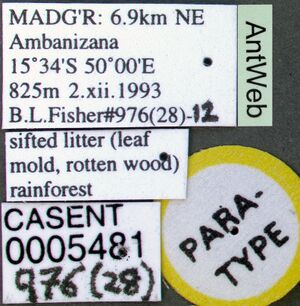Strumigenys agra
| Strumigenys agra | |
|---|---|

| |
| Scientific classification | |
| Kingdom: | Animalia |
| Phylum: | Arthropoda |
| Class: | Insecta |
| Order: | Hymenoptera |
| Family: | Formicidae |
| Subfamily: | Myrmicinae |
| Tribe: | Attini |
| Genus: | Strumigenys |
| Species: | S. agra |
| Binomial name | |
| Strumigenys agra Fisher, 2000 | |
The type material was collected from sifted rainforest litter (leaf mold, rotten wood).
Identification
Bolton (2000) - A member of the Strumigenys apios-group. S. agra and Strumigenys apios are closely related and are immediately recognizable by the tridentate apical mandibular fork, recurved propodeal spines and absence of spongiform tissue on a cylindrical-shaped petiole. S. agra is distinguished by its larger size, and chocolate brown colour.
Keys including this Species
Distribution
Latitudinal Distribution Pattern
Latitudinal Range: -15.56667° to -15.56667°.
| North Temperate |
North Subtropical |
Tropical | South Subtropical |
South Temperate |
- Source: AntMaps
Distribution based on Regional Taxon Lists
Malagasy Region: Madagascar (type locality).
Distribution based on AntMaps
Distribution based on AntWeb specimens
Check data from AntWeb
Countries Occupied
| Number of countries occupied by this species based on AntWiki Regional Taxon Lists. In general, fewer countries occupied indicates a narrower range, while more countries indicates a more widespread species. |

|
Estimated Abundance
| Relative abundance based on number of AntMaps records per species (this species within the purple bar). Fewer records (to the left) indicates a less abundant/encountered species while more records (to the right) indicates more abundant/encountered species. |

|
Biology
Castes
Worker
Images from AntWeb
   
| |
| Holotype of Strumigenys agra. Worker. Specimen code casent0005479. Photographer April Nobile, uploaded by California Academy of Sciences. | Owned by MCZ, Cambridge, MA, USA. |
   
| |
| Worker. Specimen code casent0005481. Photographer April Nobile, uploaded by California Academy of Sciences. | Owned by CAS, San Francisco, CA, USA. |
  
| |
| Paratype of Strumigenys agra. Worker. Specimen code casent0005480. Photographer April Nobile, uploaded by California Academy of Sciences. | Owned by CAS, San Francisco, CA, USA. |
Nomenclature
The following information is derived from Barry Bolton's Online Catalogue of the Ants of the World.
- agra. Strumigenys agra Fisher, in Bolton, 2000: 625, figs. 389, 410 (w.q.) MADAGASCAR.
Unless otherwise noted the text for the remainder of this section is reported from the publication that includes the original description.
Description
Worker
Holotype. TL 4.9, HL 1.13, HW 0.76, CI 67, ML 0.69, MI 60, SL 0.92, SI 122, PW 0.45, AL 1.44. Preapical dentition absent. In full-face view the short upper scrobe margin rounds cleanly into the long margin of the occipital lobe without trace of an angle, the two together forming a single evenly curved surface. Dorsum of head evenly rounded into side behind level of eye. Maximum diameter of eye distinctly greater than the maximum width of the scape. Leading edge of the long scape with a row of slender spatulate hairs which are slightly flattened. Cephalic dorsum with scale-like ground pilosity; the upper scrobe margin undefined, without a row of hairs. Cephalic dorsum with 4 simple standing hairs arranged in a transverse row close to the occipital margin. Dorsum of alitrunk without standing hairs. Ground-pilosity on alitrunk as on head. Posterior portion of mesonotum shallowly depressed below level of pronotum; propodeal dorsum concave. Propodeal teeth long, slender and curved anterolaterally; lamella absent from declivity. Alitrunk dorsum and sides reticulate-punctate. Petiole peduncle very long; node in dorsal view reticulate-punctate and much longer than broad. Postpetiole disc reticulate-punctate. Spongiform appendages of petiole absent; postpetiole without distinct lateral and ventral spongiform lobes. Basigastral costulae fine and superficial; gaster smooth and shiny when clean. Dorsal surface of postpetiole with a pair posteriorly projecting simple hairs, and posterior margin of gastral segments with standing hairs which are simple or very slightly thickened apically. Colour chocolate brown.
Paratypes. TL 4.8-5.4, HL 1.24-1.35, HW 0.68-0.77, CI 53-58, ML 0.69-0.86, MI 54-68, SL 0.85-0.95, SI 123-133, PW 0.41-0.47, AL 1.33-1.51. As holotype.
Type Material
Holotype worker, Madagascar: 6.9 Jun. NE Ambanizana, 15°34'S, 50°00'E, 825 m., 2.ix.1993, sifted litter (leaf mold, rotten wood), rainforest, #976 (20)-10 (B. L. Fisher) (Museum of Comparative Zoology).
Paratypes. 4 workers and 1 queen (dealate) with same data as holotype but coded (28)-12, (45)-12, (46)-13, (49)-9, (29)-12 (The Natural History Museum, South African Museum).
References
- Fisher, B.L. 2000. The Malagasy fauna of Strumigenys. Pp. 612-696 in: Bolton, B. 2000. The ant tribe Dacetini. Memoirs of the American Entomological Institute. 65:1-1028. (page 625, worker described)
References based on Global Ant Biodiversity Informatics
- Bolton, B. 2000. The Ant Tribe Dacetini. Memoirs of the American Entomological Institute 65
- Fisher B. L. 2003. Formicidae, ants. Pp. 811-819 in: Goodman, S. M.; Benstead, J. P. (eds.) 2003. The natural history of Madagascar. Chicago: University of Chicago Press, xxi + 1709 pp.

